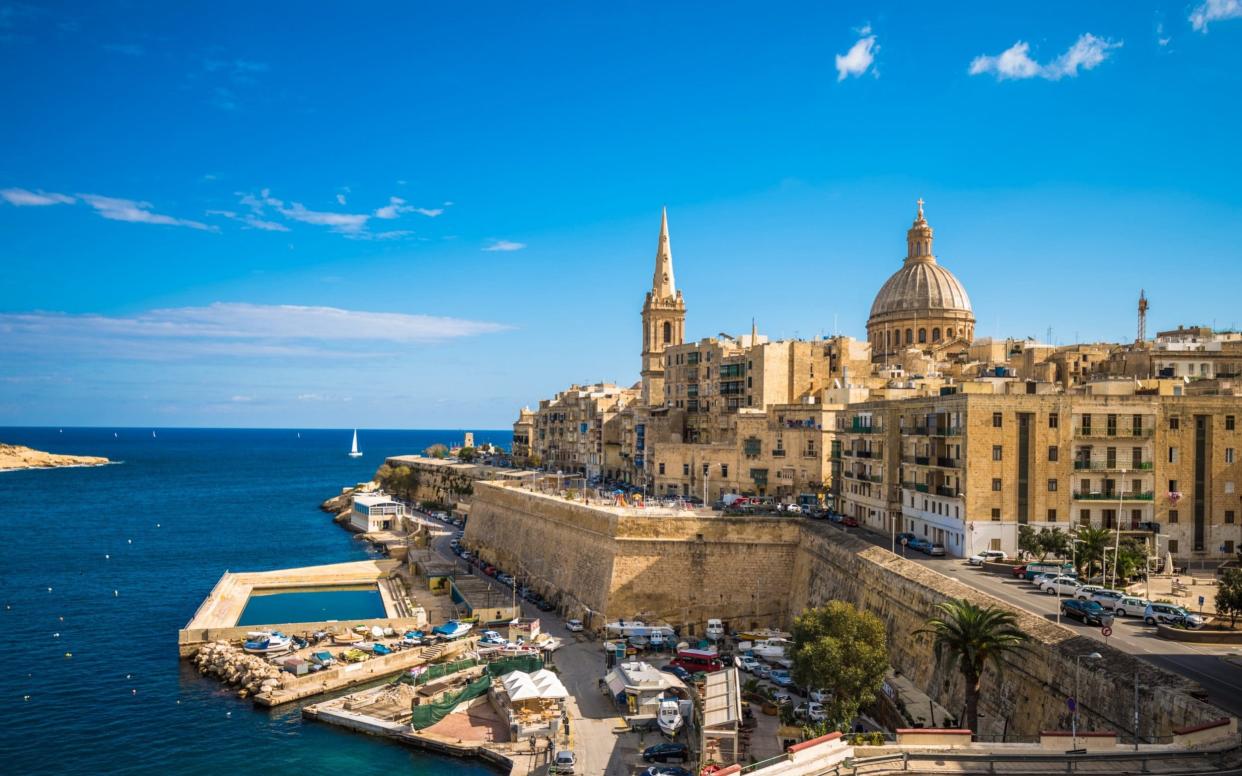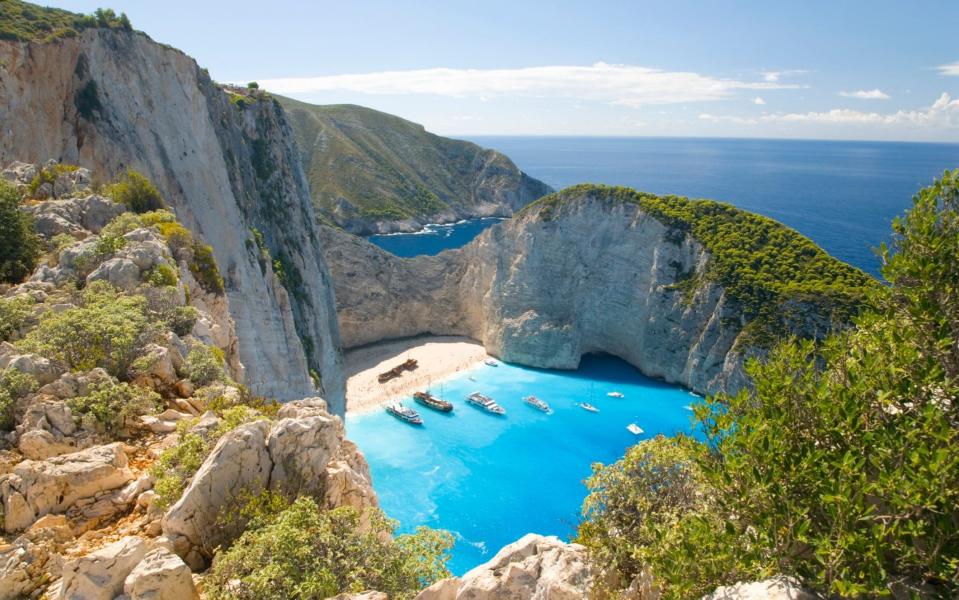The confirmed amber list countries and when you can travel to them

- Oops!Something went wrong.Please try again later.
British holidaymakers have cause for optimism as the Government has revealed the quarantine-free green list.
On May 17, the foreign holiday ban will lift and be replaced with a “traffic light” system. Transport Secretary Grant Shapps has confirmed that most European countries will be initially designated “amber”, meaning you will have to self-isolate at home for up to 10 days on your return to the UK and will be subject to extra PCR Covid-19 tests.
Prime Minister Boris Johnson said on Monday that putting a significant number of countries on the green list when overseas holidays resume would risk an “influx of disease”. He has been accused of an “overly cautious” approach by Conservative MPs and industry bosses after the European Commission proposed that fully vaccinated Britons could travel to Europe without facing testing or quarantine from as early as the start of June. However, despite this pressure, just 12 countries worldwide have been added to the green list, including Israel, Portugal, Iceland and Gibraltar.
The traffic light system only refers to rules that travellers will be subject to on their return to the UK. Some countries that qualify as “green” are not open to tourism, such as New Zealand and Australia.
Here we answer the key questions on the amber list.
What is the “traffic light” system?
A country’s vaccination rates, infection rates, the prevalence of variants of concern and its genomic sequencing capacity – or access to genomic sequencing – will help to inform its ranking in the traffic light system.
The ratings will work thus:
Green countries: no quarantine, but pre-departure and post-arrival tests
Amber countries: pre-departure test, then quarantine on arrival for up to ten days.
Red countries: banned entirely, or compulsory hotel quarantine on return (and testing)
The lists will be reviewed regularly, the Government has announced. This could mean that new countries, including some of the most popular European holiday destinations, could be on the green list by the start of June.
What does 'amber' mean?
Any travellers arriving in the UK from “amber” countries will be required to self-isolate at home for 10 days (potentially reduced with a paid-for “test to release” on day five) and to take PCR tests on (or before) day two and on day eight of isolation, as well as taking a PCR test before returning to the UK and completing a passenger locator form.
The Government currently requires each of these tests to be a PCR test, which can be costly. Prices are slowly being reduced, with one government-approved provider now charging £45.
The Foreign Office has recently updated its guidance for a number of countries. Travel insurance will be valid if travelling to a country to which the Foreign Office does not advise against travel.
Which countries are amber?
These countries are among those rated amber:
Spain
Infection rate per 100k over the previous seven days: 94.71 (all figures are correct as of May 7)
Adult population with first dose of vaccine: 32.2%
Spain will welcome British holidaymakers from June, as part of an EU-wide project to reopen for the summer season. It is likely that holidaymakers will need to arrive with some kind of Covid certification. Fernando Valdes Verelst, the Spanish tourism minister, said that a "vaccine passport" will allow Britons to travel to the country for holidays this summer. Those who have not received two doses of a vaccination will likely either need to take PCR tests prior to arrival, or have certification to prove their immunity to Covid-19.
Greece
Infection rate: 120
Population with first dose: 24.6%
Greece has lifted quarantine restrictions for UK travellers. Britons must provide evidence of a negative result from a PCR test taken within 72 hours of arrival in Greece. You will also be required to take a rapid Covid-19 test on arrival, if reaching the country by air. Those who can provide evidence of being fully vaccinated are exempt from the testing requirements. There has been speculation that some Greek islands could initially be green listed due to lower infection rates and higher vaccination rates than the mainland. This has recently been played down and no islands have made the initial green list. That said, the Foreign Office has updated its advice and no longer advises against travel to certain Greek islands.

France
Infection rate: 207.97
Population with first dose: 30.46%
British and foreign tourists with a “health pass” – either offering proof of vaccination or a negative PCR test – will be able to visit France again starting from June 9 under an ambitious lockdown exit roadmap. However, arrivals from the UK do not need to provide an essential reason to enter France. As it stands, Britons arriving in France after our foreign holiday ban lifts would be required to provide proof of a negative PCR test and would be required to self-isolate for seven days.
Italy
Infection rate: 120.72
Population with first dose: 29.72%
Italy did not make make the initial green list. However, it is permitting entry to UK travellers. According to the FCDO: "From April 7 until May 15 , entry to Italy from the UK is no longer restricted to Italian residents and those with absolute necessity," but there are still Covid measures in place. These include presenting your airline with a negative Covid test taken no more than 78 hours before travel, informing the country’s Covid-19 helpline of your visit and self-isolation for five days on arrival.
Prime Minister Mario Draghi said on May 4 that holidaymakers should book their summer holidays in Italy. He said Italy would have its own version of he EU's health pass ready by the middle of May. "Let us not wait until mid-June for the EU pass," Draghi said. "In mid-May tourists can have the Italian pass ... so the time has come to book your holidays in Italy," he added.

Croatia
Infection rate: 264.95
Population with first dose: 21.89%
Croatia's high infection rate has seen it excluded from the first release of the green list. It is allowing entry to UK travellers for defined purposes, including tourism. Britons travelling to Croatia must carry evidence of their health status (which could include evidence of a negative Covid test taken within 48 hours of arrival in the country, proof of vaccination, or a certificate of recovery from a positive Covid result in the 11 to 180 days prior).

Cyprus
Infection rate: 327.34
Population with first dose: 21.87%
Travellers visiting Cyprus from the UK are required to provide proof of vaccination from a test taken in the previous 72 hours. Cyprus has announced that from May 1 travellers with proof of two COVID-19 vaccinations completed within a specified timeframe before travel will not be required to take a pre-departure PCR test. Until there is means to certify vaccinations for international travel, you should follow the guidance above on pre-departure PCR tests.
Germany
Infection rate: 133.24
Population with first dose: 35.53%
Currently the UK is not classified as a risk area by Germany. Travellers from the UK are therefore not subject to the requirement to quarantine on arrival in Germany, and they do not need to complete pre-departure digital registration. Arrivals in Germany must possess a negative Covid-19 result prior to departure to the country. The test must be taken no more than 48 hours prior to entry.
Austria
Infection rate: 119.31
Population with first dose: 32.36%
Entry to Austria from the UK is currently prohibited by Austrian law, with some exceptions.
Belgium
Infection rate: 178.1
Population with first dose: 34.46%
British nationals who are not resident in Belgium or another EU or Schengen country will only be permitted entry to Belgium for essential reasons. Those travelling will need to carry evidence of their reason for travel.

Netherlands
Infection rate: 292.89
Population with first dose: 30.51%
Non-EU or EEA nationals (including UK travellers) are not permitted entry to the Netherlands for non-essential reasons. International travellers (aside from those with exemptions) who are permitted entry must present a negative PCR test taken within 24 hours of departure for the Netherlands.
Barbados
Infection rate: 31.71
Population with first dose: 31.5%
Barbados is due to update its entry requirements on May 8 for international travellers. As it stands, even Britons who have received two doses of vaccine will be expected to quarantine for one-two days in "approved accommodation" in addition to: providing proof of a negative PCR test result taken three days prior to travel; providing a vaccination certificate on arrival to Barbados (further details of approved certification are yet to be announced); taking a standard or rapid PCR test at the airport or accommodation; and using designated transportation providers for transport to your accommodation.
Those who have not been vaccinated must adhere to all of the above, as well as quarantining in their accommodation for five to seven days, staying within their rooms/suites before receiving a second negative PCR test result (taken on day five). As the FCO advises, “You may be required to wear an electronic tracking bracelet until you receive the results of your second test.”
It is to be expected that any other destinations that do not fall on the green or red lists will be in the amber category.
Find out which countries are on the green list here, and those on the red list here.
When will the list be reconsidered?
The traffic light lists will be reviewed regularly, which could mean by early June some of the potential amber destinations will be moved to the green list and vice versa.
Should I book a holiday to an 'amber' destination?
It would not be advisable to do so, since you will be subject to up to 10 days of self-isolation on your return and extra PCR tests that you have to pay for. If you do plan a trip to an amber list destination then you should first check the Foreign Office advice.
If the Foreign Office advises against travel to that country then your travel insurance may not be valid. Meanwhile, if the Foreign Office does NOT advise against travel to the country then a tour operator would not be required to refund your trip should you no longer wish to travel due to self-isolation or testing requirements. In this case it might be best to postpone.

